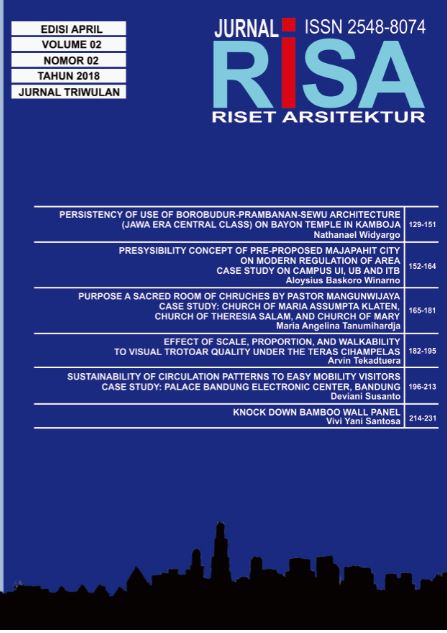PERSISTENCY OF USE OF BOROBUDUR-PRAMBANANSEWU ARCHITECTURE (JAWA ERA CENTRAL CLASS) ON BAYON TEMPLE IN KAMBOJA
DOI:
https://doi.org/10.26593/risa.v2i02.2921.129-151Abstrak
Abstract- Indonesia was in its heyday back then In the time of middle classic era of Hindu and Buddha. It is proved by many construction of big Temple such as Borobudur, Prambanan, and Sewu Temple. In Angkor Kingdom which was younger age was found alleged resemblance to the figure of Angkor temple and Prambanan Borobudur, and Sewu temple. It is also supported by the fact that in the 8th century, King Jayawarman II who built Angkor, returned from Java.The Cambodian temple research object this time is Bayon Temple which is the last civilization of Angkor Kingdom with Prambanan, Borobudur and Sewu temples as a comparative object that represents Middle Classic era of the Javanese temple architecture. The purpose of this research is to know the persistence of architectural elements (massing, plan, figure, and ornamentation) of Borobudur, Sewu and Prambanan temple (Javanese temple of Middle Classic era) at Bayon temple viewed from similarities and differences of these elements.
The research method used in this research is semiquantitative-qualitative method by observing, collecting temple data of research object, then linking data with related theory so that it becomes processed data. Data that have been processed with the theory of each temple then compared each other to get a descriptive analysis of the similarities and differences of its elements. That data was recalculated then to find the amount of similarities of the study object with the object of comparison can be found. From the analysis can be concluded that at Bayon temple there are similarities of element found with Javanese Middle Classic era of architecture, but similarities are only found on the principle of designing the mass, plan, and the figure only, while in ornaments there were found ornaments with the same type exist but not similar or not in the same place.
Key Words: persistent, comparation, essential elements of the temple, Javanese Middle Classic era of Architecture, Bayon Temple, acculturation.












